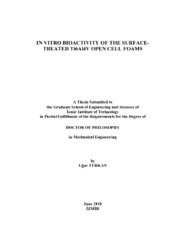Please use this identifier to cite or link to this item:
https://hdl.handle.net/11147/2980Full metadata record
| DC Field | Value | Language |
|---|---|---|
| dc.contributor.advisor | Güden, Mustafa | en |
| dc.contributor.author | Türkan, Uğur | - |
| dc.date.accessioned | 2014-07-22T13:48:41Z | - |
| dc.date.available | 2014-07-22T13:48:41Z | - |
| dc.date.issued | 2010 | en |
| dc.identifier.uri | http://hdl.handle.net/11147/2980 | - |
| dc.description | Thesis (Doctoral)--Izmir Institute of Technology, Mechanical Engineering, Izmir, 2010 | en |
| dc.description | Includes bibliographical references (leaves: 157-168) | en |
| dc.description | Text in English; Abstract: Turkish and English | en |
| dc.description | xviii, 168 leaves | en |
| dc.description.abstract | The effects of commonly used chemical surface treatment methods including alkali and nitric acid treatment and acid etching on biomimetic CaP deposition and bacterial adhesion (S. epidermidis) of an open cell Ti6Al4V foam using two different powders, powder 1 (P1) and powder 2 (P2) were investigated in a simulated body fluid (SBF) solution up to 14-day. The optimum conditions of nitric acid and alkali surface treatment for the biomimetic CaP coating of the studied foams were also determined using the surface response methodology. Alkali treatment induced a relatively thin layer of porous Na2Ti5O11 on the flat surface and inside the pores, while nitric acid treatment did not affect the surface roughness; it increased surface area difference significantly by introducing nano scale undulations on the surface. A uniform CaP layer formation was found on the flat surface and interior of the pores of untreated foam samples after 14-day of SBF immersion. However, alkali treatment and nitric acid treatment reduced the immersion time of CaP layer formation for P2 foam samples. The GIXRD, SEM and FTIR analysis showed that the CaP layer was in the form of carbonated hydroxyapatite (CHA). The porous Na2Ti5O11 surface layer formed in alkali treated foam specimens promoted the bacterial retention on the foam particles. A correlation between the nano metric scale surface roughness and the associated bacterial colonization was further shown. Based on response surface methodology, the following experimental design conditions were found to induce a uniform coating in alkali treated P1 and P2 foam specimens: 1M NaOH at 20 C for 12.5h. For nitric acid treated P1 and P2 foams, the optimum condition was found as 20% nitric acid solution at 40 C for 1h. | en |
| dc.language.iso | en | en_US |
| dc.publisher | Izmir Institute of Technology | en |
| dc.rights | info:eu-repo/semantics/openAccess | en_US |
| dc.subject.lcsh | Surface (Technology) | en |
| dc.subject.lcsh | Biomedical materials--Surface | en |
| dc.subject.lcsh | Foamed--Materials | en |
| dc.subject.lcsh | Surface chemistry | en |
| dc.title | In vitro bioactivity of the surface-treated Ti6A14V open cell foams | en_US |
| dc.type | Doctoral Thesis | en_US |
| dc.department | Thesis (Doctoral)--İzmir Institute of Technology, Mechanical Engineering | en_US |
| dc.relation.publicationcategory | Tez | en_US |
| item.languageiso639-1 | en | - |
| item.fulltext | With Fulltext | - |
| item.openairecristype | http://purl.org/coar/resource_type/c_18cf | - |
| item.openairetype | Doctoral Thesis | - |
| item.grantfulltext | open | - |
| item.cerifentitytype | Publications | - |
| Appears in Collections: | Phd Degree / Doktora | |
Files in This Item:
| File | Description | Size | Format | |
|---|---|---|---|---|
| T000853.pdf | DoctoralThesis | 32.45 MB | Adobe PDF |  View/Open |
CORE Recommender
Page view(s)
102
checked on Jul 22, 2024
Download(s)
86
checked on Jul 22, 2024
Google ScholarTM
Check
Items in GCRIS Repository are protected by copyright, with all rights reserved, unless otherwise indicated.